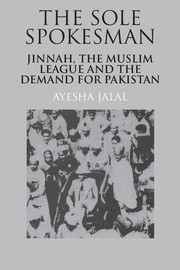Book contents
- Frontmatter
- Contents
- List of maps
- Preface
- Preface to the paperback edition
- List of abbreviations
- 1 Muslims 1931. Data by minor administrative subdivisions and major administrative divisions
- 2 Major administrative divisions
- Introduction
- 1 Jinnah between the wars
- 2 Jinnah and the League's search for survival
- 3 Jinnah and the Muslim-majority provinces
- 4 Centre and province: Simla and the elections of 1945–46
- 5 Jinnah's ‘Pakistan’ and the Cabinet Mission plan
- 6 The interim government: Jinnah in retreat
- 7 The end game: Mountbatten and partition
- Glossary
- Select bibliography
- Index
7 - The end game: Mountbatten and partition
Published online by Cambridge University Press: 01 June 2011
- Frontmatter
- Contents
- List of maps
- Preface
- Preface to the paperback edition
- List of abbreviations
- 1 Muslims 1931. Data by minor administrative subdivisions and major administrative divisions
- 2 Major administrative divisions
- Introduction
- 1 Jinnah between the wars
- 2 Jinnah and the League's search for survival
- 3 Jinnah and the Muslim-majority provinces
- 4 Centre and province: Simla and the elections of 1945–46
- 5 Jinnah's ‘Pakistan’ and the Cabinet Mission plan
- 6 The interim government: Jinnah in retreat
- 7 The end game: Mountbatten and partition
- Glossary
- Select bibliography
- Index
Summary
Since 1940 Jinnah's strategy had been based on the premise that India's unitary centre was a British creation which would automatically cease to exist when the British left India. Any new all-India centre would have to be agreed upon by Muslim provinces as well as by the Princely States. What Jinnah was clamouring for was a way of achieving an equal say for Muslims in any all-India arrangements at the centre. By denying that Indian Muslims were a minority and asserting that they were a nation, Jinnah advanced the constitutional lawyer's argument that since India contained at least two nations, a transfer of power necessarily involved the dissolution of British India's unitary structure of central authority, and any reconstitution of the centre would have to take account of the League's demand that Muslim provinces, the territorial expression of this claim to nationhood, should be grouped to constitute a separate state. Once the British and the Congress accepted the essence of the League's demands, then it remained, for Jinnah at least, an open question whether the Muslim state would enter into a confederation with non-Muslim provinces on the basis of parity at the centre, or whether, as a sovereign state, it would make treaty arrangements with the rest of India about matters of common concern.
- Type
- Chapter
- Information
- The Sole SpokesmanJinnah, the Muslim League and the Demand for Pakistan, pp. 241 - 293Publisher: Cambridge University PressPrint publication year: 1985



